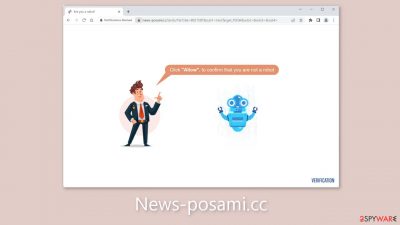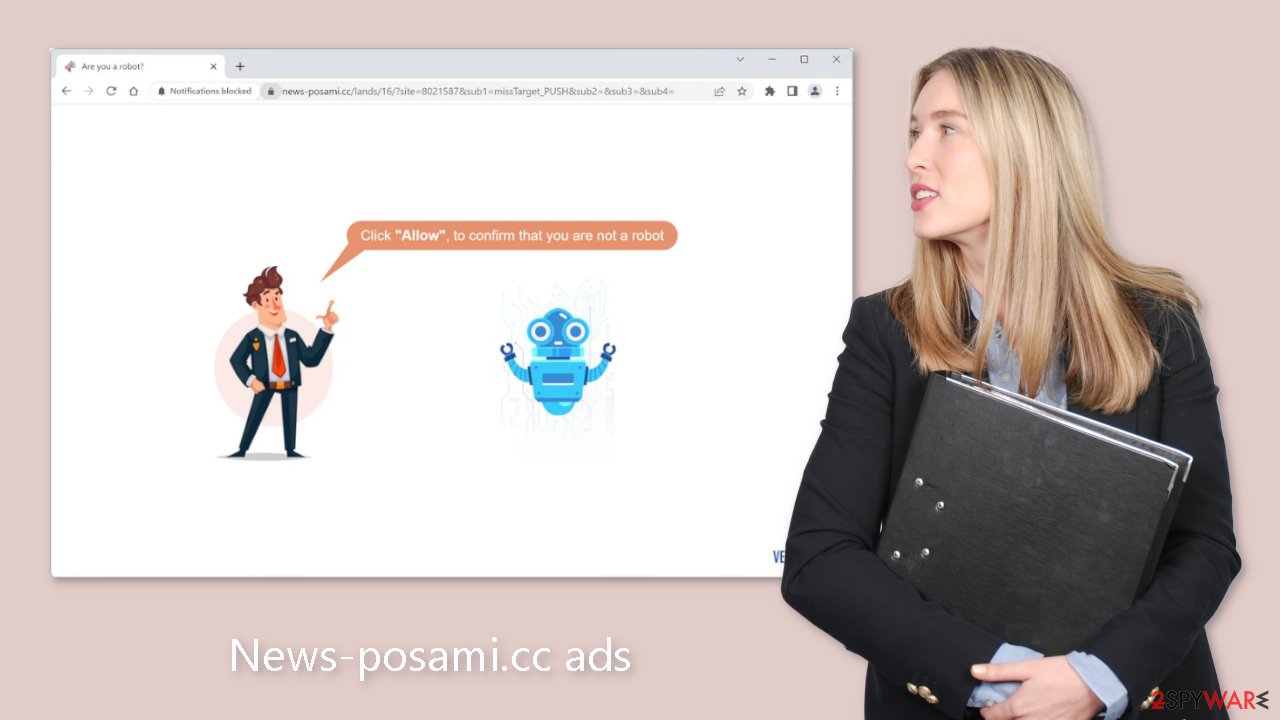News-posami.cc ads (Free Guide) - Chrome, Firefox, IE, Edge
News-posami.cc ads Removal Guide
What is News-posami.cc ads?
News-posami.cc can cause push notification spam using social engineering

News-posami.cc is a phony website created by crooks to profit from pay-per-click advertising. The site deceives users into subscribing to push notifications by pressing the “Allow” button under the guise of verifying their human status using social engineering tactics.[1]
Instead of legitimate notifications, users are bombarded with intrusive pop-up advertisements that can appear even when the browser is not open. Furthermore, the site's operators may use rogue advertising networks[2] that direct users to dangerous websites. Unsuspecting individuals may be redirected to fraudulent pages by clicking on the embedded links.
News-posami.cc scammers may attempt to obtain personal information from users or persuade them to download potentially harmful programs and malware. Some users have reported seeing ads for adult websites, bogus antivirus software, software deals, surveys, and fake giveaways.
| NAME | News-posami.cc |
| TYPE | Push notification spam; adware |
| SYMPTOMS | Annoying pop-up ads start appearing in the corner of the screen, sometimes even when the browser is closed |
| DISTRIBUTION | Shady websites, deceptive ads, freeware bundling |
| DANGERS | Links embedded in the pop-ups may lead to dangerous pages where people can get tricked into providing their personal information or downloading PUPs and malware |
| ELIMINATION | Disable push notifications via browser settings |
| FURTHER STEPS | Use a maintenance tool like FortectIntego to clear your browsers from cookies and cache |
Distribution methods
When using legitimate search engines, it is unusual to come across websites like News-posami.cc. These fraudulent sites are typically found on unregulated and dubious pages. Illegal streaming sites, for example, are notorious for hosting deceptive advertisements and covert redirects. They may also include fake “Download” and “Play” buttons that open new tabs.
We strongly advise you to stick to websites that you are familiar with and trust. Clicking on random links and advertisements, even if they appear to promote genuine products and services, should be avoided. Instead, use reputable streaming platforms such as Netflix or Hulu, which charge a reasonable monthly subscription fee and offer unlimited access to a wide range of content.

Protect your privacy
Websites now routinely prompt visitors to “Allow” cookies. These small data files can track information such as your IP address, geolocation, browsing history, clicked links, and online purchases. While this data is typically used to improve the user experience, cybercriminals can use it to make money.
Cookies can be sold to advertising networks or other third parties, and if a site lacks strong security measures, cookies can be hijacked and used maliciously. That is why it is critical to clear your browser's cache on a regular basis.
One straightforward method is to use a maintenance tool such as FortectIntego, which automates the process of deleting cookies and clearing the cache with the click of a button. Additionally, this tool can address system damage caused by malware, such as errors, corrupted files, and registry issues.
How to disable pop-ups?
The first thing you should do is go to your browser settings and see if you can disable the push notifications from there:
Google Chrome (desktop):
- Open Google Chrome browser and go to Menu > Settings.
- Scroll down and click on Advanced.
- Locate Privacy and security section and pick Site Settings > Notifications.
![Stop notifications on Chrome PC 1 Stop notifications on Chrome PC 1]()
- Look at the Allow section and look for a suspicious URL.
- Click the three vertical dots next to it and pick Block. This should remove unwanted notifications from Google Chrome.
![Stop notifications on Chrome PC 2 Stop notifications on Chrome PC 2]()
Google Chrome (Android):
- Open Google Chrome and tap on Settings (three vertical dots).
- Select Notifications.
- Scroll down to the Sites section.
- Locate the unwanted URL and toggle the button to the left (Off setting).
![Stop notifications on Chrome Android Stop notifications on Chrome Android]()
Mozilla Firefox:
- Open Mozilla Firefox and go to Menu > Options.
- Click on Privacy & Security section.
- Under Permissions, you should be able to see Notifications. Click the Settings button next to it.
![Stop notifications on Mozilla Firefox 1 Stop notifications on Mozilla Firefox 1]()
- In the Settings – Notification Permissions window, click on the drop-down menu by the URL in question.
- Select Block and then click on Save Changes. This should remove unwanted notifications from Mozilla Firefox.
![Stop notifications on Mozilla Firefox 2 Stop notifications on Mozilla Firefox 2]()
Safari:
- Click on Safari > Preferences…
- Go to the Websites tab and, under General, select Notifications.
- Select the web address in question, click the drop-down menu and select Deny.
![Stop notifications on Safari Stop notifications on Safari]()
MS Edge:
- Open Microsoft Edge, and click the Settings and more button (three horizontal dots) at the top-right of the window.
- Select Settings and then go to Advanced.
- Under Website permissions, pick Manage permissions and select the URL in question.
![Stop notifications on Edge 1 Stop notifications on Edge 1]()
- Toggle the switch to the left to turn notifications off on Microsoft Edge.
MS Edge (Chromium):
- Open Microsoft Edge, and go to Settings.
- Select Site permissions.
- Go to Notifications on the right.
- Under Allow, you will find the unwanted entry.
- Click on More actions and select Block.
Adware removal
Even after you disable notifications, your system may still be infected with adware. An increase in commercial content, such as surveys, banners, pop-ups, and redirects, may be one of the symptoms. If you notice any of these symptoms, we strongly advise you to use professional security tools such as SpyHunter 5Combo Cleaner or Malwarebytes to scan your machine for malicious software.
Antivirus software can detect suspicious processes on your system and remove all associated files. It can also prevent future infections by alerting you to potentially harmful downloads. While you can try to remove unwanted programs manually, it can be difficult to identify potentially unwanted programs (PUPs)[3] because they are frequently disguised as seemingly legitimate tools like antivirus software, system optimizers, media players, and so on.
Besides, manual removal can sometimes result in a renewal of the infection, as people fail to eliminate all the related files and entries. Otherwise, if you want to perform manual removal, you can follow the instructions posted below for Windows and Mac systems:
Windows 10/8:
- Enter Control Panel into Windows search box and hit Enter or click on the search result.
- Under Programs, select Uninstall a program.
![Uninstall from Windows 1 Uninstall from Windows 1]()
- From the list, find the entry of the suspicious program.
- Right-click on the application and select Uninstall.
- If User Account Control shows up, click Yes.
- Wait till uninstallation process is complete and click OK.
![Uninstall from Windows 2 Uninstall from Windows 2]()
Windows 7/XP:
- Click on Windows Start > Control Panel located on the right pane (if you are Windows XP user, click on Add/Remove Programs).
- In Control Panel, select Programs > Uninstall a program.
![Uninstall from Windows 7/XP Uninstall from Windows 7/XP]()
- Pick the unwanted application by clicking on it once.
- At the top, click Uninstall/Change.
- In the confirmation prompt, pick Yes.
- Click OK once the removal process is finished.
Mac:
- From the menu bar, select Go > Applications.
- In the Applications folder, look for all related entries.
- Click on the app and drag it to Trash (or right-click and pick Move to Trash)
![Uninstall from Mac 1 Uninstall from Mac 1]()
To fully remove an unwanted app, you need to access Application Support, LaunchAgents, and LaunchDaemons folders and delete relevant files:
- Select Go > Go to Folder.
- Enter /Library/Application Support and click Go or press Enter.
- In the Application Support folder, look for any dubious entries and then delete them.
- Now enter /Library/LaunchAgents and /Library/LaunchDaemons folders the same way and terminate all the related .plist files.
![Uninstall from Mac 2 Uninstall from Mac 2]()
How to prevent from getting adware
Choose a proper web browser and improve your safety with a VPN tool
Online spying has got momentum in recent years and people are getting more and more interested in how to protect their privacy online. One of the basic means to add a layer of security – choose the most private and secure web browser. Although web browsers can't grant full privacy protection and security, some of them are much better at sandboxing, HTTPS upgrading, active content blocking, tracking blocking, phishing protection, and similar privacy-oriented features. However, if you want true anonymity, we suggest you employ a powerful Private Internet Access VPN – it can encrypt all the traffic that comes and goes out of your computer, preventing tracking completely.
Lost your files? Use data recovery software
While some files located on any computer are replaceable or useless, others can be extremely valuable. Family photos, work documents, school projects – these are types of files that we don't want to lose. Unfortunately, there are many ways how unexpected data loss can occur: power cuts, Blue Screen of Death errors, hardware failures, crypto-malware attack, or even accidental deletion.
To ensure that all the files remain intact, you should prepare regular data backups. You can choose cloud-based or physical copies you could restore from later in case of a disaster. If your backups were lost as well or you never bothered to prepare any, Data Recovery Pro can be your only hope to retrieve your invaluable files.
- ^ Social Engineering. Imperva. Learning Center.
- ^ Zeljka Zorz. How does a rogue ad network function?. Helpnetsecurity. Information Security Blog.
- ^ Chris Hoffman. PUPs Explained: What is a “Potentially Unwanted Program”?. Howtogeek. Technology Magazine.












